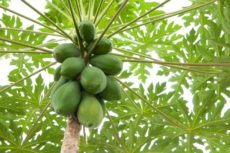How to Grow Paw Paws in Perth
Carica papaya
The fruit in Australia referred to as paw paw - also known as the papaya – is Carica papaya. It is a fast growing small to medium tree that originates from southern Mexico and Central America.
It is often cultivated as a garden tree due to its attractive shape, striking foliage and, of course, the delicious fruit it produces. They originate in tropical and sub tropical areas and are highly productive for 5 to 6 years. The bisexual paw paws are generally self-pollinating. They grow quickly and produce plentiful supplies of fruit in a relatively short time. This makes them quite a short-lived tree.
The fruit can be used for sauces, salads, skewered with fish or meat on barbeques and for medicinal purposes. The ripe fruit has a sweet tropical flavour and makes a great breakfast dish. Fruit can also be eaten green and has a tart flavour, which makes it a great addition to Thai style salad.
Position
Because they are a soft type tree, and susceptible to frost and cold winds, they should be grown in a sheltered, warm location that replicates their sub tropical origins.
They will also do well in a pot that can be moved to the optimal location each season. They can make a lovely indoor specimen plant during winter when they need protection from frost damage.
They thrive in a compost rich, free draining soil with regular food, but don’t be tempted to over feed them. In areas with clay, the soil will need to be improved well with organic content and the tree planted on a rise to aid drainage.
When do I plant my paw paw?
The smaller the tree the more sensitive it is to cold. Therefore, plant after the last threat of frosts has gone and the soil is warm. This will usually be from the beginning of November to February.
Give your tree a chance to be established before winter arrives and frost or severe cold can cause damage. Young trees may need to be protected from frost during winter for the first couple of years.
Planting and care
Water the pot before planting your tree into the ground. See our tips on提高你的土壤种植前for full instructions. Apply a seaweed tonic such as Seasol when watering in.
Keep well watered and fed during summer as they are gross feeders and grow very rapidly. They benefit from additions of compost and aged manure, which will help maintain soil health and water retention.
They have shallow root systems and are susceptible to wet feet. Water regularly but make sure the soil is free draining to avoid root rot. Mulch with a 100mm layer of quality organic mulch keeping the mulch well back from the trunk of the tree.
Paw paws are susceptible to common garden pests, including fruit fly, birds and possums. See our range of netting and exclusion products to assist in combating these.
They can also be susceptible to powdery mildew and black spot in colder climates. Remove the affected growth or treat with a recommended fungicide if affected.
Harvesting
If you plant between November and January, you will be picking your first crop between October and December of the following season. Pick when the fruit is firm. If you are worried about pests, pick earlier and keep indoors in a position next to a banana to encourage ripening.
Pruning
Generally they don’t require much pruning, but as they grow too tall to harvest the fruit then they can be cut off to a manageable height. This should be done in the warmer weather.
Please note that this is intended as general information only. Please ask one of our qualified horticulturists for more specific advice for your situation.
Want to keep a copy of this information for yourself? Download a copy to your computer.
Want to grow some Paw Paws in your own garden?

